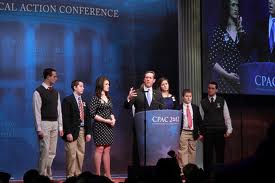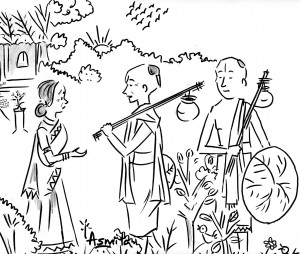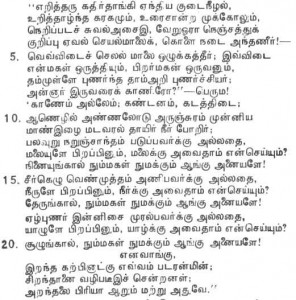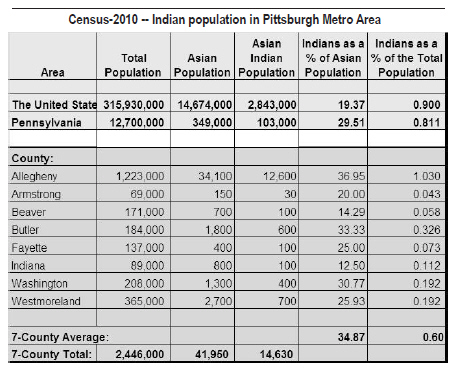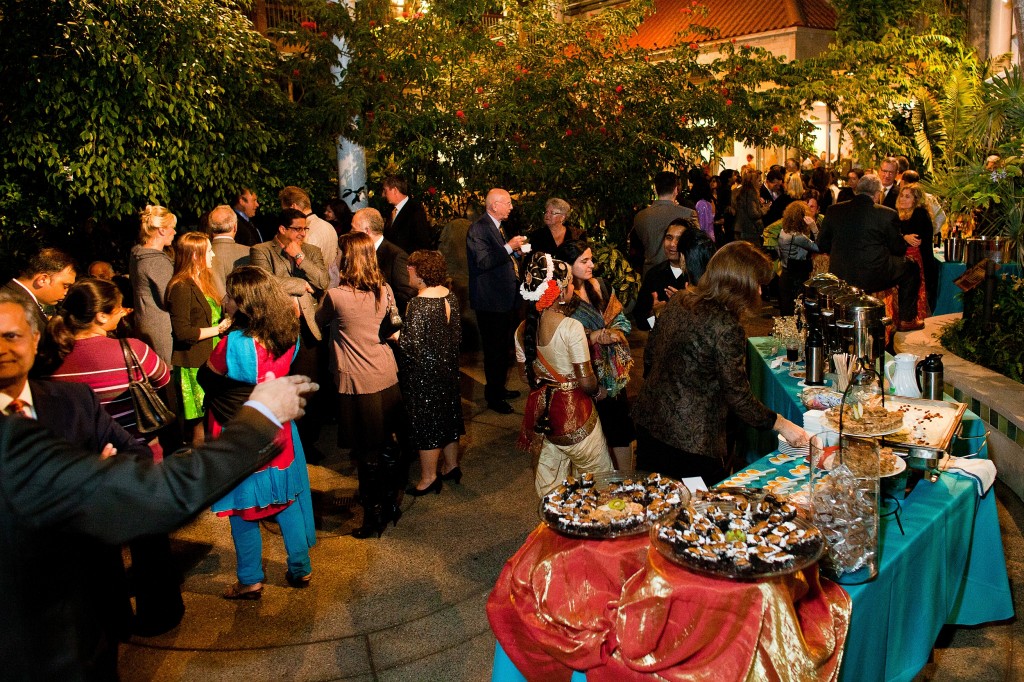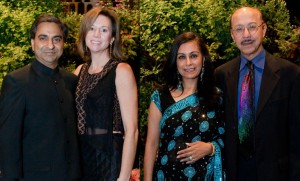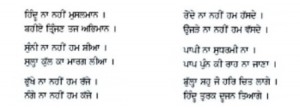Archive for category Past issues
Something to Ponder Over When You Leave for Colleges
 By Kollengode S Venkataraman
 Our graduating list gets more impressive every year. Over sixty of you young men and women are leaving for universities, and three or four times that many are entering high school this Fall from our area. Congratulations, and a few words for you to ponder over before you start your classes.
By now all of you would have read Dharun Ravi’s case in New Jersey. Ravi was sentenced to a 30-day jail term for videotaping while at Rutgers his gay college mate Tyler Clementi’s intimate private moments, and then tormenting him by making the information public. Feeling harassed by the involuntary exposure of his homosexuality, Clementi killed himself by jumping off a New York bridge.
 Beyond the narrow legalities, there are ethical issues here for you.
 Being a minority yourself on many counts, while growing up here, some of you would have felt uncomfortable for getting singled out and made fun of, often unintentionally and in jest, by your “mainstream” buddies. This experience has been a rite of passage for every new immigrant group in the US who came before us – Italians, the Irish, the Polish, Jews… . The Black experience is very harsh on account of slavery and race.
This experience notwithstanding, when you go to school this Fall, most of you will actively seek entry and acceptance into the “American mainstream,” however you define it. An easy way to achieve this, you may think, is to outdo your “mainstream” buddies in internalizing their collective likes and dislikes, do’s and dont’s. This is natural, unavoidable, even understandable.
In your efforts to meld with the American mainstream, you will be serving yourself better by reminding yourself that as the latest arrival into this country, you are yourself a minority. Also remember, by many objective measures, many of you belong to what can be called a “privileged minority.”
 Therefore, whatever you do to find acceptance, do not offend or humiliate your classmates on account of who they are and what they are.
After all, you had no say on where you were born and which family you were born into; or the ethnic and religious background you inherit. And, you certainly had no choice on the combinations of chromosomes and the DNA with which you were born.
 So, temper your youthful, tribal instincts to find acceptance into your group, and use your sense of fairness, and do not do to others what you would not like done to you.
All the best in Fall. Have fun and widen your horizon with what you see and hear both inside and outside the classroom.
Fasting Helps Remove Waste at the Cellular Level
 By Kollengode S. Venkataraman
 In February 2012, Gretchen Reynolds’s article* in the New York Times discussed the benefits of physical exercise in terms of “house-cleaning of the body” at the cellular level. For the biologically challenged engineers, technologists, doctors and others: Cells are the basic structural and functional units of all living organisms. They are the building blocks of life itself. Living organisms can be very simple unicellular species such as bacteria, or can be multicellular like plants and animals. Humans are composed of several trillion cells of different types in different combinations, varying in size between 1 to 100 microns visible under microscopes. One micron is 1/1000th of a millimeter.
*http://well.blogs.nytimes.com/2012/02/01/exercise-as-housecleaning-for-the-body/?src=rechp
What follows in italics is my summary of a part of Reynolds’ longer article. The words within quotes are Reynolds’ own words.
We all know about the benefits of physical activities and exercise: Good blood circulation and working the muscles and joints help to scavenge out the waste products of metabolism that accumulate in the body. We feel fresh and rejuvenated.
Cell biologists have known for a long time that waste products accumulate in cells during routine daily activity. These trash heaps of debris contain “broken or misshapen proteins, shreds of cellular membranes, invasive viruses or bacteria, and worn-out, broken-down cellular components … … within cells.”
Often cells sweep away these waste products, sometimes even wrapping them in special membranes within the cells and breaking them into simpler bits (or oxidizing them) to generate energy. This process is called autophagy, literally “self-eating.” Without this efficient cleaning system, the trash would congest the individual cells, and the healthy cells would die. Faulty autophagy is believed to be at the root of many diseases such as diabetes, muscular dystrophy and others. The slowing down of autophagy is believed to contribute to aging.
The self-cleaning autophagy, cell biologists believe, evolved in living organisms in response to the stress associated with starvation when living organisms on and off did not get enough food. When food is scarce, “cells would round up and consume superfluous bits of themselves to keep the rest of the cell alive. In petri dishes, the rate of autophagy increases when cells are starved or otherwise placed under physiological stress.”Â
Exercises are physiological stress. But until recently, few researchers had thought to ask whether exercise might somehow affect autophagy within cells, and if so, what their influences to the body as a whole are. In controlled experiments, researchers found that mice having better autophagy were able to stay active before getting fatigued compared to the mice having poorer autophagy built into their cells.
I was astonished at how nature works in preserving its species even during starvation through autophagy. Starvation is externally imposed. Lower animals’ and plant species’ only response to starvation is to adapt or die. Animals starve when food is scarce, as when monsoons fail, or during massive deforestation, or new aggressive and voracious species are introduced in their habitats depriving food to existing species.
Human beings too have to adapt to changes from outside. But humans have the capacity to proactively bring about changes using their will power, as during fasting. Fasting, of course, is different from starving. The driving force for fasting is the power of the will where everything edible is available, but you do not eat them by choice by exercising your willpower. Since you do it by choice, you do not feel deprived.
In India, many traditional observers of religious rites periodically practice what is known upavaasam – literally meaning “subsistence living.” Jains and many Hindus fast for several days during the Chatumaas in the rainy season. Hindus fast on Ekadashi – the entire 24-hour duration of the eleventh phase of the waxing and waning moon every month. Muslims too, once a year, fast for 12 hours or longer during Ramadan.
Can human beings, using their willpower, deny their body food so that at the cellular level, they can initiate autophagic “housecleaning” and burn the cellular-level wear debris into energy, as can happen during fasting? The answer seems to be”yes.” If you web-search the phrase “Fasting and Autophagy,” you get a ton of affirmations from practitioners of fasting and even scientific studies on the subject.
So, is it worthwhile complementing daily exercise with fasting once a month for 24 hours, as many traditional Jains and Hindus practice even today?
It definitely is worth trying, provided you have the willpower to deny yourself of food for twenty-four hours in this gluttonous part of the world! ï®
Sarcasm and Humor in Sanskrit Literature
Beyond devotional hymns, mantras for pujas, Yogasutra and Kamasutra, there is more to Sanskrit — such as treatises on grammar, music, dance, astronomy, geometry, medicine, surgery and statecraft. When all these heavy subjects are in Sanskrit, humor and sarcasm cannot be far behind.
Here is an example of sarcastic wit in classical Sanskrit one finds in Economics of Lord Mahavira by Acharya Mahaprajna (Publishers: Jain Vishwa Bharti, Rajasthan, India, 2001). The Acharya’s thesis is that simply correlating wealth accumulation and consumption with happiness is a wrong way to assess progress. He avers that this is sure to lead to personal disenchantment. When accumulation of wealth leads to high material inequities as it is now globally, we can infer that it can also lead to social strife.
While pleading for moderation and social responsibility, the Acharya makes it clear that poverty is a curse. Sannyasam (renunciation) becomes a problem if not done with the correct attitude. Otherwise the sannyasis (renunciates) — and married priests as well — become parasites since they expect married lay householders to support them. We see this in all religions. In making the case against poverty, the Acharya uses biting wit to convey his message.
In Patanjali’s Yoga Sutras, one of the siddhis (accomplishments) for an adept yogi is that the yogi can make himself so small that he invisible to others. This siddhis is called aNimaa. This, the yogi accomplishes, after a long and strenuous practice of what Patanjali calls Samyamas.
The Acharya, quoting a Sanskrit verse, says in sarcastic humor that without having to go through all the arduous Yoga practice, one indeed becomes invisible in society when afflicted with poverty. Acharya Mahaprajna is referring to the reality of successful/famous people not even recognizing their poverty-stricken relatives and friends in social gatherings (such as weddings).
Here is the Sanskrit verse dripping in Sarcasm, composed by an unknown poet afflicted by poverty, who had seen better days:
 Translation:
Translation:
In the October 2011 issue, we had published a medieval Sanskrit verse composed in the 16-syllable Anushtub-chandam like most of the verses in Bhagavadgita. We deliberately did not give the meaning, hoping that a few readers would ask for its meaning. And a few of you did. Here is the original verse in the Devanagari script:
Here is the translation of the verse addressing a Vaidya, or a doctor:
 O, Doctor, the brother of Yama (Death)! Salutations to you. Yama only steals [people’s] lives. But you, doctor, steal [people’s] lives and money as well.
So, the contentious relationship between doctors (and the healthcare industry) and patients we see today in the US and in India is nothing new. ♠
Family Pictures in Political Rallies
Posted by admin in April 2012 on April 8, 2012
In this raucous primary season for the presidential elections, for a change, Republicans, known for their sedate intramural debates, are entertaining us with their mean-spirited name callings. After the elections in primaries, even those who come third and fourth deliver “victory†speeches, often with their families as backdrops. US politicians, unlike their counterparts in other democracies, surround themselves with their spouses and progeny in campaigns to reassure voters that they are honÂorable family men, which most of them are most of the time — and not scoundrels, which some of them are, some of the time for sure.
![]() Sen. Rick Santorum, father of seven children, and Gov. Mitt Romney, father of five sons, touted their family backgrounds using their wives and children as “optically“ effective props. Being seasoned pols, they contrastÂed themselves from their leading Republican threat at one point, Speaker Newt Gingrich, subliminally taunting him for his far from flawless conjugal life — three marriages, divorcing his first two wives under circumstances far from acceptable in candidates seeking the US presidency.
Sen. Rick Santorum, father of seven children, and Gov. Mitt Romney, father of five sons, touted their family backgrounds using their wives and children as “optically“ effective props. Being seasoned pols, they contrastÂed themselves from their leading Republican threat at one point, Speaker Newt Gingrich, subliminally taunting him for his far from flawless conjugal life — three marriages, divorcing his first two wives under circumstances far from acceptable in candidates seeking the US presidency.
The air-brushed photos of these candidates with large families stand in sharp contrast to married couples in the US having fewer and fewer children. Besides, college-educated married couples, irrespective of their religious affiliation and ethnicity, often have fewer children, someÂtimes, no children. Paradoxically, families from this slice of the population are the well-informed, having all the resources for raising kids.
 So, Romney (a Mormon) and Santorum (a Catholic), having large famiÂlies are exceptions because both are well educated and wealthy. So, RomÂney and Santorum are to be admired for having large families. DemographiÂcally that is exactly what we need. Our aging soÂciety is primed by service industry jobs. If we cannot get youngsters from our own population pool for these jobs — either because of the harsh working conditions or low pay (usually both) — there is no way we can avoid getting them from poorer nations, legally or illeÂgally. This is a global trend. Even in populous nations such as India, China, Mexico, and Brazil, there is huge influx of less-educated poor people from rural parts to urban centers, and from their neighboring countries.
So, Romney (a Mormon) and Santorum (a Catholic), having large famiÂlies are exceptions because both are well educated and wealthy. So, RomÂney and Santorum are to be admired for having large families. DemographiÂcally that is exactly what we need. Our aging soÂciety is primed by service industry jobs. If we cannot get youngsters from our own population pool for these jobs — either because of the harsh working conditions or low pay (usually both) — there is no way we can avoid getting them from poorer nations, legally or illeÂgally. This is a global trend. Even in populous nations such as India, China, Mexico, and Brazil, there is huge influx of less-educated poor people from rural parts to urban centers, and from their neighboring countries.
But all the family-value campaign rhetoric notwithstanding, US is not family-friendly for people to wanting have large families. The 6-week maternity leave for working mothers with newborn babies in the US is a scandal. In industrialized countries in Europe and Asia, and even in our neighboring Canada, maternity leave is for several months, with the mothers getting almost 80% of the salary. See here for getting a comparison:
www.catalyst.org/publication/240/family-leave-us-canada-and-global
Further, in urban centers across the nation, quality new-born and early childcare is prohibitively expensive (over %2500/month) for median-income working families. College education too is expensive.
After repeatedly seeing pictures of the Santorum and Romney families in campaign rallies, I wonder how the Family-Value conservatives and Teapartiers would react if they see pictures of large families of working class Blacks, Latinos or brown South Asians in the US in newspaper stories?
Or if they see minority working-class families with five or six kids in tow walking in shopping malls?
Or God forbid, if the Family-Value conservatives see legal minority parents with four kids in tow in grocery stores paying in Food Stamps at the checkout counters?
Also, ummmm… … one wonders if the current occupier of the White House would have even dared to seek the office if he and his wife had five or six children, a la Santorum and Romney?
Keeping Kids Culturally Connected
Posted by admin in April 2012 on April 8, 2012
Â
By Mona Chabra
e-mail: mona15143@yahoo.com
Note: A native of Pittsburgh, Mona earned her degree in Writing from Edinboro University of Pennsylvania and works as a freelance writer for Pittsburgh Parent Magazine.
When we think of culture many things come to mind. We can taste culture in the sweetness of baklava from the Middle East. We can see culture in the intricate designs of Japanese origami. Culture adds depth to our world and makes it unique. Culture shapes how we think and behave. Culture gives us a sense of belonging and identity.
But what do we do when distance comes between our cultural roots and the place we call home? It’s simple… just replant them!
That’s exactly what so many ethnic groups have done. Take our own for example! Most families of Indian origin take culture and tradition very seriously. From preparing authentic Indian food to speaking Hindi, Gujarati, Marathi, Bengali, Tamil… … Most families of Indian origin settled in Pittsburgh follow many Indian customs and traditions at home on a daily basis. By doing so, these customs and traditions, key elements of them, anyway, will be preserved from generation to generation.
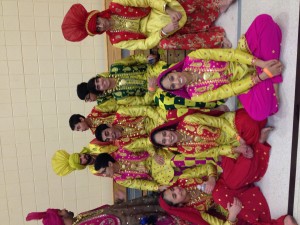 Like so many young people with multicultural backgrounds, good friends Amal Chabra and Sahil Dadoo recognize that it’s important for young people to stay connected to their cultural ethnicity so it can be passed on to coming generations. That’s why these kids have taken extra steps to hang on to their heritage. And, instead of sitting their cultures out, they’ve chosen to dance Bhangra, one of India’s most happening traditions!
Like so many young people with multicultural backgrounds, good friends Amal Chabra and Sahil Dadoo recognize that it’s important for young people to stay connected to their cultural ethnicity so it can be passed on to coming generations. That’s why these kids have taken extra steps to hang on to their heritage. And, instead of sitting their cultures out, they’ve chosen to dance Bhangra, one of India’s most happening traditions!
 “Though Bhangra is one of the most operose arts to perÂfect, there is nothing I enjoy more. It’s not only a lot of fun, but through the music, lyrics, costumes and moves, I learn a great deal about my Indian heritage,†says Amal. “My passion to reconnect with my roots has no limits!†Sahil agrees, “I think it’s important to for me to stay connected to my culture and traditions because then later on in life, I can pass these traditions down to other people and connect them to the Indian culture.â€
Bhangra is a buoyant and lively form of expression that will engulf you in its spirit as soon as you experience it. It’s a celebration of life and is done with zest, enthusiasm and energy.
Two well-established bhangra teams in PittsÂburgh are First-Class Bhangra (FCB) and (its younger verÂsion) First-Class Bhangra Juniors (FCBJ). Both groups have competed and performed in several venues throughout the US and are available to perform at both public and private events.
FCBJ currently consists of nine team members ranging in ages from fourteen to seventeen. But, according to the team’s leader/instructor, Ram Mahalingam, FCBJ plans to expand to enhance its stage presence for performances as well as competitions.
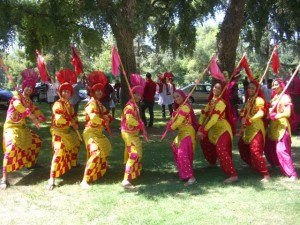 Born and raised in the US, Ram developed his passion for Bhangra at a young age. “I saw Bhangra as a hard dance style that provided me with a challenge, so I decided to give it a try.â€
Born and raised in the US, Ram developed his passion for Bhangra at a young age. “I saw Bhangra as a hard dance style that provided me with a challenge, so I decided to give it a try.â€
A recent graduate of the University of Pittsburgh, Ram has been actively involved in Bhangra for the past eight years. This year marks his fifth year of competitive Bhangra as well as teaching. ‘Being a teacher gives you so much joy when watching others and the success that they achieve. I think it’s great that the kids take such an avid interest in something that is culturally relevant to them. I do it for that love.†Ram says.
Ram also feels privileged that he can help bridge cultural gaps for so many kids just like himself. “I think it’s important for generations to get a taste of culture and try to understand why things are culturally important.â€
Ram has great expectations for FCBJ. “I know when their high school days are up this experience will have shaped them to be a model student and citizen at their colleges. They’re great kids and make me proud!â€
Lost in Translation — Almost!
Posted by admin in April 2012 on April 8, 2012
During the Cold War governments arbitrarily imposed and scrapped, raised and lowered import and export duties to punish and favor other countries or their own industries. The GATT (General AGreement on Tariffs and Trade) — which later evolved into the WTO (World Trade OrganiÂzation – wanted to stop this to stabilize trade among nations and interlink humanity for improving the quality of life and reducing the threat of large scale war. It came up with the policy that “a country should not discriminate between its trading partners (giving them equally ‘most-favored-nation’ or MFN status).†Granting MFN simply means that one nation will not arbiÂtrarily discriminate against others by erecting capricious trade barriers.
India granted Pakistan MFN status in 1996, but Pakistan did not reÂciprocate. But Indian goods enter Pakistan through Dubai at increased cost for ordinary working class Pakistanis. Smuggling of goods from India is also rampant. So, in November 2011, Pakistan decided to grant India the MFN status, which only means that Pakistan would treat India as it treats its all other trading partners.
But nothing is simple in India-Pakistan relations given the 70-plus years of bitterness – the Pakistan Resolution (1940); India’s colonial occupier Britain in 1947 hastily and arbitrarily partitioning the subcontinent into India and Pakistan; murder and rape of millions of Hindus, Sikhs and Muslims in the Partition; 3-1/2 wars (1947, 1965, 1971, and 1999); and the divergent understanding of the earlier Turkic/Persian/Afghani/Mongol invasions and the Mughal rule over India. The only thing common between the two are mutual suspicion, sense of betrayal, which often morph into hatred.
For Pakistan, it was difficult to sell the idea of granting the MFN status to India through the Urdu press dominated by the mullahs. Pakistani ofÂficials told their Indian counterparts that their biggest difficulty in granting MFN status to India is that its Urdu translation will create havoc. The Most Favored Nation status would be translated literally into Urdu as Subse Chahati Mulk, or Sabse Qaribi Mulk, or Sabse Pasandeed Mulk, or Sabse Inaayati Mulk, or Subsay Dularee Qaum. In Urdu, chahati, qaribi, pasandeed, inayati, and dulari respectively mean desired, closer, desired, favored, and darling.
These phrases, when taken literally by a population unfamiliar with the nuances of the history of WTO and international trade, would mean that the Pakistani government is getting cozy with India. In Pakistan, where hatred of India is part of the school curriculum, these Urdu expressions are triggers for the Islamic fundamentalists and the mullahs to cause trouble for the government. That is how things almost got lost in translation.
Finally, beginning 2013, trade between India and Pakistan would be normalized, insha Allah!! — By KSV
Book Review: Vivaha Samskara
Posted by admin in April 2012 on April 8, 2012
The Details Vedic Hindu Wedding
Reviewer: Praful Desai, Greensburg, PA
VivÄha SamskÄra – The Hindu Wedding Ceremony, by Deepak A Kotwal, Narayan B Datar, Arun D Jatkar, and Dilip Amin. Publishers: World Hindu Council of America, 2011 (161 pages). $12. Copies can be purchased at www.Hindu-Wedding.org, or at the SVTemple or the H-J Temple.
The book Vivaha Samskara was conceived, as Deepak Kotwal writes in the preface, when he wanted to understand the religious rites while organizÂing his own daughter’s marriage. The book, organized into chapters and appendices, begins with a discussion of the sixteen Vedic samskaras (rites of passage) and the four ashramas (stages of life) of the Sanaatana Dharma, describes the seven key elements of the Vedic vivaha ceremony.
The authors then unfold the symbolic significance of steps in the marÂriage ceremony, giving the hymns in Sanskrit with detailed instructions for conducting weddings. The authors also discuss interfaith marriages and offer young couples suggestions for avoiding potential conflicts because of differences in faiths. The final chapter and the several appendices give logistical details of the marriage ceremony.
The authors succeed educating and empowering Hindu young adults entering the married stage of life in offering a well-organized, clearly arÂticulated picture of the religious, spiritual and sociological significance of the marriage rites. The book fulfills the needs of both Hindu and non-Hindu families for understanding the Sanskrit-based Vedic marriage rites.
The authors invite couples embarking on grahasthashrama (householder stage of life) to regard the vivaha ceremony as a affirmation of their verbal commitment to each other into an indelible accord with community elders, while seeking blessings from the Vedic deities. Complete with the details of rituals and hymns in the Devanagari script with English transliteration and translation, the book is a good source for English-speaking people to grasp the Vedic wedding samskaras.
In writing the book the authors consulted with traditional Hindu priests from North and South India conducting marriages. This gives gravitas to the book as a reference for priests or anyone wishing to conduct a Vedic wedding. The authors maintain a fine balance between vivaha samskara, and their implications for moral guidance.
Finally, the book is a valuable contribution to Hindus and the growing number of intercultural families in the Diaspora as they strive to preserve the essentials of Sanatana Dharma in an ever-changing world. Vivaha Samskara would be an asset in every family library.
Book Review: “I Said it Too” on Diaspora Desis
Posted by admin in April 2012 on April 7, 2012
Reviewer:Â Premlata Venkataraman
I said It Too – Chai with Mahendra, a cartoon book by Mahendra Shah, Published by Mahendra Shah, 203 pages. Copies can be purchased ($20) from www.bookganga.com/eBooks/Books?BookSearchTags=i+said+it+too&BookType=1
Pittsburgh’s own Mahendra Shah, known to most readers of this magazine, has compiled several of his cartoons published in various forums, magazines, and dailies into a book “I said it too!”
Like the other world famous cartoon series You Said It by the celebrated Laxman in the Times of India, Mahendra Shah uses his wit and pencil to look at the Indian Diaspora’s hyphenated existence in the United States and bring into focus the absurdities such cultural mingling brings about.Â
His keen observations encompass our homes life, our parties and social interactions, our temple committees, and our growing distance from our children raised in this culture. Not one aspect of our lives – including our stinginess — has been left undisturbed by Mahendra Shah’s sharp mind. Â
 Shah’s cartoons offer as much commentary about our life here as those written in scholarly journals and opinion pages — except he does it with a few strokes and a pithy sentence that gently poke fun at our communities foibles and conflicted existence. His cartoons describe the pros and cons of attending events; high price of tickets; the larger effort of cooking halwa for 100 guests; the annoyance of attending multiple weddings for the same couple based on religious-cultural-regional differences. He also mocks at religious fanaticism and doctor/patient interactions, and editors (with rare exceptions) who treat him badly.
Shah’s cartoons offer as much commentary about our life here as those written in scholarly journals and opinion pages — except he does it with a few strokes and a pithy sentence that gently poke fun at our communities foibles and conflicted existence. His cartoons describe the pros and cons of attending events; high price of tickets; the larger effort of cooking halwa for 100 guests; the annoyance of attending multiple weddings for the same couple based on religious-cultural-regional differences. He also mocks at religious fanaticism and doctor/patient interactions, and editors (with rare exceptions) who treat him badly.
That both this book and the Vivaha Samskara reviewed elsewhere in this issue have been self-published by the authors is a sad reflection of ourselves, given that we brag about our high education, high earning power, and our high net worth.
These and similar works chronicle the life of Indian Americans in a new land, and hence are valuable source of information for someone in the future wanting to study the trajectory of Indian immigrants becoming part of the American mainstream.
An Evening of Poetry Reading in Hindi and Urdu
Posted by admin in April 2012 on April 7, 2012
By Ramona Sahni, Fox Chapel, PA
e-mail:Â ramonasahni@yahoo.com
Note: Ramona Sahni, a long-time member of the Indian community here, came to the US in 1971 as a resident in medicine. She and her husband Randhir Sahni live in the Fox Chapel area (Hartwood Estates).
Triveni International Club, which was dormant for some time, showed a splendid revival last Fall by sponsoring an enjoyable mushaira (creative poetry recitation) at the India Garden restaurant in Monroeville. It seemed like a divine intervention, the weather cooperated beautifully, no coats or umbrellas were required, and the food was fresh and wholesome. In the filled-to-capacity hall, the mood was expectant.
A diverse and renowned group of poets and authors enlivened the mushaira, a classical tradition of reading original Urdu poetry by Shairs and Shairas. Young and seasoned, men and women, hailing from different walks of life, read their verses, tastefully, often forcefully. There was also room for ribaldry. But all conveyed their passion, insight, and emotion. Men and women from our own area and those from neighboring states, some coming from Canada, and a few poets visiting from India delighted the packed lively audience.
The evening started promptly at 5 PM with appetizers followed by dinner. The program commenced at 7 PM instead of 7:30 PM as announced — a first for Pittsburgh! — to an eager crowd of patrons.Â
Participants adhered to the traditional boundaries of mushairas, which transported me to an age long gone — lighting of the candle by Shaheen Akhtar invoking the Divine illumination, nuanced approach to etiquette, and reverence shown to the Sadramushiara Maqsad Allahabadi — brought back memories of my younger days.
The poets used a colorful palette expressing love, pathos, loss & separation, longing for re-union, humor, satire and social themes. Everyone brought their unique life experiences into sharp focus in their recitals.Â
Credit goes to Durlabh Trivedi who organized this event almost single handedly. And what is a man without his wife? Santosh, Durlabh’s wife, hosted many of the artists at their home. Thanks go to Shaheen Akhtar and Hussein Imam for their efforts to get the artists, and to the Triveni board’s hard work, including the youngest member, Amit Grover. The program went on till late into the night.
The delightful evening made everyone introspective and nostalgic. We hope the Triveni Club continues to deliver this way, so we can all stay proud of our culture and heritage.
A Vignette in Indian Literature: Young Women Picking Their Own Mates not Unusual,
Posted by admin in April 2012 on April 7, 2012
By Kollengode S Venkataraman
Asmita Ranganathan of South Hills drew the sketches that nicely embellish the story.
In the last issue, Dilip Amin’s article elegantly persuaded readers – mostly Indian immigrant parents — to take in their stride interfaith marriages among their children. Amin also informed youngsters of the important issues they need need to sort out before, the issues they may gloss over during courtship.
Girls choosing their mates on their own is not unusual if you go by Indian legends. The story of Nala and Damayanti, among others, in Mahabharata is one example. In another, Shakuntala, the daughter of Kanwa rishi (sage), and prince Dushyanta fall in love, and even conceive a baby “out of wedlock” in today’s parlance. In other Indian literature too, young women falling in love with men is portrayed in diverse situations with all the intense emotions it generates.
Readers may know that Tamil, a stand-alone classical language like Sanskrit, Hebrew, Chinese, Latin and Greek, has a large collection of literature spanning over 2500 years, many of them now not extant. Kalittogai, whose time is before or around the beginning of the Common Era, is one such anthology of 150 free-style poems in classical Tamil, many dealing with love’s many fascinating manifestations portrayed in vignettes.
A verse in Kalittogai by king Perum-kadum-Ko, describes a situation that is contemporary for all ages. Ko in old Tamil means king. In ancient India, it was expected that kings, powerful landowners, and rich merchants be trained in the aesthetics of literature, music, and dance. Naturally, many of them were patrons of arts. This Kalittogai poem is set in a fascinating backdrop:
A middle aged woman, the mother of a young adult daughter, finds at daybreak that her grown-up daughter is not home. She remembers seeing her daughter going to bed the previous night. She knows that her daughter was in love with a young man in the neighborhood. Not finding her daughter, the mother panics that she might have left the village with her lover. Looking for her daughter in panic along the pathway leaving the village, she sees a group of Brahmin ascetics walking briskly towards her.
How does she know they are Brahmins? Well, they are carrying a Tri-Dandam (a stick made by tying together three branches of a special tree) carried by Brahmin sannyasis even today, to which they have tied their alms-collecting bowls (bhiksha-patram).
The poem is composed as a conversation between the panicked mother and the wayfaring Brahmin recluses on a pilgrimage:
“O Brahmins, with a tri-dandam on your shoulder to which you have tied your alms-collecting bowl, and carrying umbrellas to shield against the hot sun, your single-minded brisk walk and demeanor tell me you are on a pilgrimage. Along way you came by, did you see my daughter and a stranger’s son walking together in love with each other?”
“We cannot say we did not see. O mother of the attractive, courageous young woman who chose to leave with a young, handsome man! We did see them walking past us! Panic not! Now listen:
“Fragrances growing in the forest on the hill only benefit the people who daub themselves with their pastes. What use are the fragrances for the hill? Coming to think of it, your daughter too is like that to you.
“Lustrous pearls growing in waters beautify only those who wear them. What use the pearls have for the waters? Coming to think of it, your daughter too is like that to you.
“The melodic music coming from the seven-stringed yaazh (a harp-like ancient Tamil instrument not available now) is only for those who enjoy its music. What good is the music for the yaazh itself? Coming to think of it, your daughter too is like that to you.”
Comforting the panicked mother thus, the wayfaring Brahmins reassure her further: “You return home in peace of mind. And do not be in grief thinking that your daughter has run away. She is a virtuous woman. Do not cause her any harm. She has gone with a good and honorable man. Her actions do not violate the Natural Order of things in life.”
Now when we put this 2000-year old verse’s import in the context of Dilip Amin’s suggestions and counsel in the last issue to parents and youngsters contemplating interfaith marriage, we see a fascinating continuum between Amin and the Brahmin ascetics.
The Kalittogai verse is cast in the context of a mother’s panic on her daughter choosing her life partner on her own. However, the imageries in the Brahmin ascetics’ advice to the panicked mother are as much valid to situations in which our young men and women choose their life partners on their own, much to the anguish of their parents.
For those who can read Tamil, the original Kalittogai verse is given below*. If you can read Tamil, you will find that this classical Tamil is very different from your day-to-day contemporary masala Tamil, or even the Tamil you read in popular magazines. If you plough through reading it, I am sure you will appreciate its literary nuances.
Â
Celebrating Tagore’s 150th Birth Anniversary
Posted by admin in April 2012 on April 7, 2012
Nidrita Mitra Sinha & Samar Saha
e-mail: nidrita26@gmail.com & samar_k_saha@yahoo.com Â
Sri Venkateswara Temple auditorium was packed on Saturday, November 26 last fall to celebrate Rabindranath Tagore’s 150th Birthday Anniversary. Pittsburgh Indians paid tribute to their great poet through Tagore’s poems, songs, and his dance-drama Chitrangada by the students of Nandini Mandal’s Nandanik Dance Academy.Â
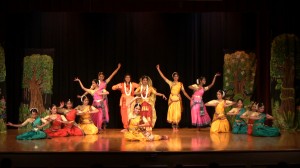 The first part was presented with a garland of three poems and three songs, each accompanied by dances expressing the sentiments of Puja (Devotion), Prakriti (Season/Nature), and Prem (Love) – three themes of Tagore’s forte.
The first part was presented with a garland of three poems and three songs, each accompanied by dances expressing the sentiments of Puja (Devotion), Prakriti (Season/Nature), and Prem (Love) – three themes of Tagore’s forte.
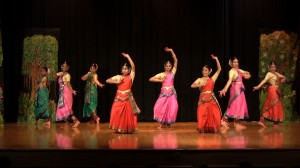 The poetry recitations, by Sujatha Sundar (in Tamil translation), Maneesha Cleetus (in Hindi translation), Nidrita Mitra-Sinha in Bengali original, and Nandini Mandal in English translation, brought out the true emotions of each poem. The choreography for the dance was excellent and the supporting dances performed by Poorwa Godbole, Mohini Walavalkar, Roosha Mandal and other younger adults went well to set the mood for the next part.
The poetry recitations, by Sujatha Sundar (in Tamil translation), Maneesha Cleetus (in Hindi translation), Nidrita Mitra-Sinha in Bengali original, and Nandini Mandal in English translation, brought out the true emotions of each poem. The choreography for the dance was excellent and the supporting dances performed by Poorwa Godbole, Mohini Walavalkar, Roosha Mandal and other younger adults went well to set the mood for the next part.
In the second part, Tagore’s dance drama Chitrangada was presented. Tagore wrote Chitrangada in 1892 when he was barely 32. But the storyline is as compelling today as it was then.Â
The story of Chitrangada is a small episode in the ageless Hindu epic Mahabharata. The story in its original form is distinctly macho and reads like another conquest of Arjuna. But Tagore took the story, gave it a feminine twist, and transformed it into a modern musical. Tagore retold the story with a remarkable fusion of oriental and occidental ideas on the femininity with a vision that sensual love may begin its bloom as an entrapment created by our sensory perception of external beauty and youth. But after the initial bursts are over, love is freed from that illusion into the greatness of austere truth that a love which never learns to go beyond the physical appearance knows no real fulfillment, no peace, and is, therefore, unreal. Â
Chitrangada’s feminist undertones, subtle emotions, messages, and Tagore’s own poetic sweep over the original story demanded only the best out of the performers. And the members of the Nandanik Dance Academy did deliver. The participants gave their best in bringing this masterpiece to life. Nandini Mandal as the director, choreographer, costume designer, and prima ballerina was simply outstanding. It was a moving experience to observe how warrior princess Chitrangada (Nandini) and her alluring incarnation (Mohini) put their heart and soul to bring out the agonies and ecstasies of love in each act.
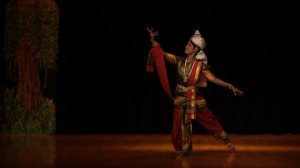 Their every move, facial expression and body sway fluidly poured out the emotions embedded in the story.
Their every move, facial expression and body sway fluidly poured out the emotions embedded in the story.
The songs recorded in India under the direction of Late Roma Mondal, and narrations by Pittsburgh’s own Brita Chakrabarti were commendable. The dancers brought out the real emotions with every musical note.
The dances presented in Manipuri, Kuchipudi, Bharatnatyam, and Kathakali styles with tastily done costumes, simply added to the grandeur and elegance to the play. The colorful costumes uniquely blended with the mood of the songs and with each act.Â
Aparna Roli Nigam’s performance as Arjun of Mahabharata needs special mention as she brought out the male emotions impressively. Similarly, the performances of Rachana Lanka as god Madana and the little children in the Deer Dance were adorable. The technicians managing the audio and lights should be thanked for a job well done.  n
Nritya Sangam : confluence of four classical Indian dance forms.
Posted by admin in April 2012 on April 7, 2012
 by Nandini Mandal, Mt. Lebanon, PA
e-mail: nandini@nandanik.net
Nritya Sangam, an Indian classical dance program organized last fall organized by Kamala Reddy’s Kala Niketan showcased four classical dance styles of India – Kathak (by Sudeshna Maulik), Odissi (by Shibani Patnaik), Kuchipudi (by Kamala Reddy) and Bharatanatyam (by Sruti Javali). The recital at the Shady Side Academy’s Fox Chapel campus on Saturday, December 3, captivated the nearly packed auditorium of ticket buying audience on that nippy evening.
 The Evening started with a Pushpanjali. Sruti set the mood with a prayer to Ganesha in Shankarabharanam followed by Shibani’s prayer to Brahma, the creator, rendered in Vaasanti. Reddy followed with a piece in praise of Vishnu with the music set in Shuddha-saveri. And Sudeshna paid obeisance to Nataraja and Durga, with the verse rendered in Mishra Kafi. Towards the end, the four dancers appeared together on stage giving the recital in their own distinct styles for the same melody (in Desh) and laya (rhythm) patterns as the finale to the Pushpanjali.
 Sruti Javali followed with her Shadakshara Kautuvam, choreographed by Priyadarshini Govind, in which the dancer elegantly used Madurai Muralidharan’s signature composition on Kartikeya. Shibani Patnaik‘s Varsha Varnalee next described the cyclical journey of water rising as dark clouds from the ocean; and moving over land, become rain drops and then heavy rains; the rain water flows in streams becoming gushing rivers softly merging into the ocean. And the ocean water again rises as clouds, with the whole sequence resembling the cycle of life itself. This Odissi piece was original in thought and presentation, while firmly rooted in its classical idioms. The first half ended with a collage of episodes from the life of Krishna.
 The second half opened with the Ananda Tandavam by Kamala Reddy in Kuchipudi style. Reddy presented Shiva Tandavam with crisp razor-sharp movements and freezes keeping the audience engrossed.
 This was followed by Sudeshna Maulik’s Kathak Swaroop, presenting the nritta aspects of Kathak. Expecting the traditional “idioms” of Kathak (as mentioned in the brochure) in this piece, I was kind of disappointed. The costume also was a little too innovative for the traditional nature of presentation of the other styles. Sticking to tradition would have fitted well, given that the audience got to see the four different styles together after a very long time.
 The seven dance styles of India – all based on the same essentials in the Natya Shastra — are yet unique not only in form and technique, but also in costume, presentation, musical repertoire. Sudeshna is a talented, young dancer trained by the likes of Guru Rani Karnaa, Pandit Birju Maharaj, and Sri Jaikishen Maharaj. Her sharpness of angik, or technique, was brilliant. So, expectations were more from her.
 The highlight of the evening was the final presentation of Samvad — a dialogue in laya in a blend of Tillana and Tarana. The dancers used elaborate geometric patterns to traverse the entire stage space. This presentation was the perfect culmination of dance and music for the evening. The conversation among the adavus of Bharatanatyam and arasas of Odissi, the tukras of Kathak and the jatis of Kuchipudi was spellbinding. The recital ended with the Shanti mantra. A perfect melbandhan.
 As we all know, nritya-geet-vadya (dance, music and rhythm) go hand in hand. Dance especially is dependent on lyrics, melody and rhythm. The music for the evening’s recital was simply mind-blowing. It is a dancer’s dream to dance to music of such richness. This being the case, except in one item, nowhere during the show, or in the brochure were the composers’ or musical ensemble’s details mentioned.
 For such an elegant and resourceful auditorium, the general lighting was also quite wanting.
Â
Â
Ha! Ha!!
Posted by admin in April 2012 on April 7, 2012
 From Classical Sanskrit Poetry (only in translation)
 On Wealth:
 What you give to charity
and what you use for day-to-day
 That I hold your wealth to be.
 The rest, with someone else will stay.
Â
 With a hoarder’s wealth others toy —
 It is like honey, which some amass,
 while others enjoy.
 — Bana Bhatta (7th Century) Sanskrit poet
Â
For Ron Paul’s and other Tea Partiers’ Delight:
 If the bureaucrat could never eat
 his mother’s flesh while in her womb,
 the only reason for this feat was,
 at that time, he had no teeth!
 — Prakashavarsha (9th century) Sanskrti poet A.N.D. Haksar’s translation of
 Subhaashitaavali
(Penguin Classics, 2007).
Â
Money causes pain in getting;
 In the keeping, pain and fretting;
 Pain in loss and Pain in spending.
 Damn, the pain never ending!
 — From the Panchatantra
(2nd Century AD), A W Ryder
Census-2010 Update on “Asian Indians†in Southwest Penna
Posted by admin in January 2012 on December 23, 2011
By Kollengode S Venkataraman
OK. The details of the 2010 US Census containing all kinds of data that can be summarized, parsed, sliced and diced in countless ways are now available online. Extracting the info you want, however, is another matter. You will need a coach — either a virtual one, or a person who can walk you through to navigate the site.
With help from Dr. Amitabha Das (amitabha.das@census.gov) at the US Census Bureau, I learned the basics of extracting data from the 2010-Census database.
In the October-2010 issue, I wrote an article titled “Counting Indian-Americans in Pittsburgh… …” giving the county-by-county numbers of the Indian population in the seven counties around Pittsburgh on the basis of Census-2000 data. The summary of my article was as below.
Allegheny County: 11,800
The remaining 6-counties combined: 2,600
Total: 14,400.
The Census-2000 did not identify Indian Americans as a separate demographic group. However, for Allegheny County it estimated that Indian-Americans are 41.1% of the total Asian population. I estimated the Indian population in the neighboring counties assuming that Indians make up 40% of the Asian population. The Census-2010 data suggest that this assumption was incorrect.
The 2010-Census counts Indian-Americans as a separate group, classifying them as Asian Indian. The table below gives the number for Asian Indians (or Indians) for the seven counties along with the numbers for the entire US and the commonwealth of Pennsylvania.
Several points are in order.
1. The Indian-American population in the US now stands at 2.84 million, accounting for 0.90% of the nation’s population. In Pennsylvania, the Indian population�in the�Census-2010 is�103,000, or 0.81% of the population. In the census in 2000, the Indian population in the state was 88,000, which was 0.713% of Pennsylvania’s popultion of 12 million then.
2. Indian-Americans, by and large, are very urban�– we are City Slickers. For example, 12,600 Indians are in Allegheny County (population 1.223 million with the City of Pittsburgh having over 300,000). But only 2000 Indians live in the seven neighboring counties (with a combined 7-county population of 1.2 million).
3. Â In Allegheny County, the Indian population icreased from 11,800 in 2000 t0 12,600 in 2010, which is a respectable 6.7% increase ofer the ten year period.
4. The 2010 Census numbers reveal that the Indian population as a % of the Asian population is not around 40%, the number I used in my earlier calculation, but much lower. While it is close in Allegheny County (37% of all Asians), in the remaining six counties, it is much lower: 12.5% (Indiana County), 25.9% (Westmoreland County), 33.3% (Butler County), and 30.8% (Washington County).
From the 2010 Census data shown in the table�above we can estimate that in the seven counties surrounding Allegheny County, Indian-Americans account for only 25.9% of the Asian population.
The Census-2010 data show that 12,600 Indian-Americans live in Allegheny County alone, and another 2000 of us live in the adjacent seven counties combined.
In these eight-counties, now 14,600 Indian-Americans call this region their home. �
Campaign Rhetoric in Kentucky — A Rite of Passage for American Hindus
Posted by admin in January 2012 on December 23, 2011
By Kollengode SÂ Venkataraman
“All is fair in love and war†is a clichéd adage, to which we can also add “in business too,†till one gets caught. David Williams, Kentucky’s Republican candidate for the governor’s race in last November crudely exemplifies this. Williams was trailing badly behind his Democratic incumbent opponent, Gov. Steve Beshear, who participated in a bhoomi pooja (ground-breaking ceremony) for a $180-million factory. The plant, to be built by an Indian-American Hindu entrepreneur, will directly employ 250 Kentuckians, giving jobs to another 750 people indirectly. Unemployment in Kentucky was 9.7% in November 2011.
Williams plastered all over the photo of Beshear participating in the Bhoomi Puja saying, “[Beshear] is there participating with Hindu priests, participating in a religious ceremony. He’s sitting down there with his legs crossed, participating in Hindu prayers with a dot on his forehead with incense burning around him. I don’t know what the man was thinking.†He added this gem: “I think you disrespect other people’s religion when you go down there [to their places of worship].†A detailed report is here:
 http://www.kentucky.com/2011/11/01/1943049/williams-blasts-beshear-for-participating.html
Using Williams’ twisted logic, all non-Christians who have participated in Christian weddings sitting in the pews of churches uttering “amen†along with others, or have gone to the Christian funeral services, have disrespected Christianity.
Before one reacts to William’s bigoted view towards the Hindu religion, one needs to understand the history of this nation. Even decades after the Civil War, the attitude of the powerful white American Protestant establishment towards Blacks, and Jews & Catholic immigrants from Europe was along similar lines. After a period of considerable soul-searching, the Protestant establishment reconciled the different faiths under the rubric of “Judeo-Christian†heritage, which seems to work fine for the most part. Post 9-11, the American establishment tries to reconcile with Muslims with the inclusive phrase “Abrahamic faiths.†But reconciliation is too far away. Where do the agnostic Buddhists, atheistic Jains, monist Sikhs and the “idolatrous†Hindus fit into this? Given the history of the internecine wars among the Abrahamics, many non-Abrahmics may think, “Leave us alone.†You may wonder why? There are reasons:
Here is the attitude of 4th century Syrian-born Christian Theologian Saint Ephrem, who composed a hymn in Syriac in praise of his faith that is racist by today’s norms (Ref: All is Change – The Two-Thousand-Year Journey of Buddhism to the West by Lawrence Sutin, p. 31, Little, Brown and Company, New York (2006)). Translation below:
The sun-burnt India you [that is, Christianity] have made fair…
A tainted land of dark people, you [Christianity] have purified.
More than snow and white linen
The dark bride of India, you [Christianity] have made fair… …
The crown of light has obliterated India’s darkness shades.
During the Colonial days in India over a millennia later, the attitude of the newly landed European Christian missionaries towards Hindus was worse. The European missionaries were dictating to Hindus what was right in matters of faith without even caring to know the Indian spiritual ethos. Francis Xavier (1506 – 1552), later canonized as St. Xavier, representing the Vatican in India, was responsible for unleashing the Inquisition of Hindus in Goa with support from the Portuguese rulers, similar to inquisition of Jews and Muslims in Portugal. Search the web for Goa Inquisition for more details. Incidentally, the fashionable, upscale St. Xavier’s College in Mumbai where Mumbai’s elite Hindus send their sons and daughters, is named after the same inquisitor St. Xavier. Â
Let us also not overlook the behavior of elected officials of our own ilk in the US. Louisiana governor Bobby (Piyush) Jindal (R) did not even want to be seen in the White House Deepavali where nobody had to sit cross-legged on the floor. South Carolina’s Nikki Haley (R) walked away from her Sikh/Hindu heritage to get elected as governor. Luckily, we have Dalip Singh Saund (D) (1899-1973) for inspiration. He did not change his name and his faith –- he was a Sikh — and yet got elected to the US Congress from California in 1956 under even harsher environment.
Given this history, how should the Hindus in the US respond to the Republican and Protestant David Williams’ diatribe against the Hindu faith? First, let us appeal to Yahveh Himself, paraphrasing the words of His only Son: “Forgive Dave, O Lord, for he knows not what he says. He is swirling in blind faith, ignorance, and prejudice.†Yahveh just might forgive Williams. But Kentuckians did not. Williams lost big time to Beshear in the election — 56% to 35%. In his victory speech, Beshear was candid: “In the election, we asked voters to send a strong message against … … the politics of religious intolerance. Today, they sent the message in the strongest possible terms.†Amen, Governor Beshear!
Williams is not the only one in this genre. Republican Governor Robert J. Bentley of Alabama last January said this after taking office: “Anybody here today who has not accepted Jesus Christ as their savior, I’m telling you, you’re not my brother.†(Ref: “Southern Hospitality, but Not for Newcomers,†Opinion piece by Yunte Huang, NY Times, November 19, 2011). Mercifully, later Bentley apologized for his statement.Â
We are likely to have more Williams and Bentleys in the years ahead. But taking inspiration from the Black, Jewish, Catholic, Chinese, and Japanese experience, we need to react nondefensively, and with grace and confidence, and tell that the diatribes like those of Williams and Bentleys are our Rites of Passage for getting melded into the American mainstream. I am sure, Mainstream-USA will be with us on this.
As the latest immigrants, it is now the Hindus’ turn to endure, notwithstanding our better education, professional careers, and middle class lifestyle. For Hindus here to stand against religious bigotry, they don’t have to be “modern†and “western educated.†They can go to their own Indian roots. For that go the story titled “India’s Centuries Old Fight Against Religious Bigotry” elsewhere in the website.  ï®
Environmentalist Vandana Shiva Excoriates Corporatization of Farming
Posted by admin in January 2012 on December 23, 2011
By Premlata Venkataraman Â
Ms. Vandana Shiva, the renowned environmentalist, passionately spoke against the corporatization of farming while speaking to an overflowing crowd of students at Point Park University on November 2, 2011.
Shiva is known for her adversarial approach to encroachments on environment by for-profit multinational corporations grabbing resources in the name of progress. In a free-style and passionate address, she enumerated the hidden costs for this “progress†to a young and well-informed audience.
Her address focused on globalization and its negative impact on environment and the working poor all over the world. Current trade regulations and the blatant patenting of intellectual property rights, she told, essentially give a legal cover to rapacious multinational corporations to grab resources from unsuspecting citizens, clueless and/or corrupt politicians and government officials, and an indifferent middle class.
In addition, the toxicity of the herbicide pollutes the soil, killing the natural biodiversity evolved over tens of thousands of years. The recent diminishing number of Monarch butterflies and the disappearing of bees in the US are attributed to these practices. She pointed that while Earth will withstand these ravages, plants, animals and humans may not be able to survive the devastation.
“Agribusiness interests have created monocultures in soils,†she said referring to the practice of one or two grains – like cotton, corn and soybeans — planted over large tracts of lands over and over again.
Maximizing profits as their only criteria, soya, corn, canola, and cotton are the only preferred choices. This causes additional financial burden on subsistent farmers who now have to buy all their food. Genetically modified techniques have decimated thousands of varieties of cotton to a handful. Further, feeding cattle soya and corn instead of grass make their stomach more prone to outbreaks of diseases. Â
“Cultivating diversity in nature is as important as diversity in populations,†she reasoned. Attitudes like, “If you are not with us you are against us,†are as harmful for plant biodiversity as it is for nation-states.
Shiva also stressed on the need for water conservation to ensure everybody has access to it. Companies like Coca Cola have expanded all over the globe, eating up resources. They draw millions of liters of water from wells, thus lowering the water table, impoverishing rural villages. Recently Kerala state in India successfully ousted Pepsi citing wasteful water consumption.
She also touched on the issue of fracking in Pennsylvania for natural gas, which has the potential for poisoning water. She finished her lecture touching on the Occupy Wall Street movement, which is the response of the helpless citizens to the recent trend in the huge inequities in income, wealth and access to resources. Towards the end, the responded to several questions from the students. ï®
Tropical Forest India Exhibit Outlined in Phipps’ Wines Under the Glass Gala
Posted by admin in January 2012 on December 23, 2011
by Premlata Venkataraman
The soft melodic notes of the bamboo flute wafted through the lush dark green foliage of the plants at the twilight hour. Dwaraka? Mathura ? or the famed Vrindavan? No. This was the Phipps Conservatory in Oakland on Friday, October 21 during The Green Heart of Pittsburgh Award and The Passage to India celebration. The latter was a prelude to the 3-year long Tropical Forest India live exhibit beginning in February 2012 thru 2015.
The evening gala, appropriately called Wines Under the Glass, featured excellent wines and delectable hors d’oeuvres, many of them Indian, all made by Phipps’ kitchen staff.
Phipps Director for Development Campaign Ben DuFour said over 400 guests attended the ticketed gala, almost an overflowing gathering of people for the hall.
Many of the Indian women clad in their finest silks with attendant jewelry were well-complemented by Indian men in Nehru jackets or Western suits. The pleasant Fall evening was further enlivened by the live jazz band.
Sunil & Nita Wadhwani, and Anuj Dhanda & his fiancé Anne Nemer, were the honorary cochairs for the evening. In keeping with the atmosphere of the evening, all speakers were brief.

PNC’s Executive V.P. Anuj Dhanda (L) and Chief Financial Officer Rick Johnson (R) with the Green Heart Award with Phipps’ Richard Piacentini (C).
India is not new to Phipps. In 2003, it organized Medicinal Plants of India exhibit; and currently it supports two botanists’ work in India through its Botany In Action program.
Unfurling the details of the Tropical Forest India, Phipps’ Executive Director Richard Piacentini said, Phipps horticulturalists and education experts spent considerable time traveling in India’s Western Ghats to ensure that the exhibit will be the finest. From February 2012 thru January 2015, Phipps’ Tropical Forest Conservatory will transform into India’s Tropical Forest. The exhibit will host public events on the plants, cultures and people of India – all against a lush backdrop of India’s plants and trees.
The evening began with the annual Green Hearts Award presented to the Heinz Endowments and PNC Financial Services Group for “their commitment and leadership roles on environmental issues.â€
Phipps’ Piacentini, making the award to the Heinz Endowments, said, the Heinz Endowments help develop solutions to regional community challenges that are national in scope, He added “Phipps has worked with the Heinz Endowments over the years in the sustainability movement that Teresa Heinz launched here locally in the 1990s.â€
Making the award for the PNC Financial Group, he said PNC has more newly-constructed “green†buildings certified by the U.S. Green Building Council than any company in the world, adding “as Pittsburghers, we’re all anxiously awaiting PNC’s new green sky-rise office tower downtown. Phipps is proud to call PNC a partner in our many programs and plans for the future.â€
The 800,000 sq. ft. 40-storey PNC headquarters to be built at a cost of $400 million, will be completed in 2015. This will be the world’s most ecofriendly corporate headquarters. The 150-year old PNC Group has 60,000 employees nationwide.
The Heinz Endowments President Bobby Voigt, and PNC’s Executive Vice President Anuj Dhanda and Chief Financial Officer Rick Johnson received the Green Heart Awards from Phipps’ Piacentini.
Towards the end, Nita Wadh- wani introduced the audience to flavors of India’s classical and contemporary dances. Kala Niketan’s Soumya Rajupet, and Nandanik Dance Group’s Aparna Roli Nigam, Roosha Mandal, and Vishmaya Saravanan rendered short dance pieces in the Indian classical styles. Ruby Jain provided a contemporary and glamorous Bollywood piece.
Ajit Ranganathan, with Charan Rajan on the mrdangam, wielded the pleasing bamboo flute and set the atmosphere for the evening. Nita introduced these artistes also to the audience. The piece de resistance of the evening was the ambience of Phipps conservatory itself.
— Photographs by Renee Rosensteel  ï®
Medical Tourism Helps Desperate Patients & Raises Ethical Issues
Posted by admin in January 2012 on December 23, 2011
Dr. Kris Gopal. M.D.,F.A.C.S.     e-mail:   gutcut@comcast.net
Wealthy patients and politicians from developing countries have always traveled, and continue to go to developed countries or to neighboring countries for medical treatment 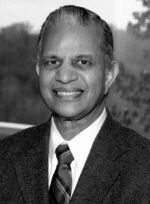 not available in their own countries. Now, a growing number of less-affluent patients from developed countries (North America and Western Europe), in what is called Medical Tourism, travel to regions once pejoratively called the “Third World†for medical treatment. These patients seek, often desperately, medical care that they cannot afford in their own countries.
not available in their own countries. Now, a growing number of less-affluent patients from developed countries (North America and Western Europe), in what is called Medical Tourism, travel to regions once pejoratively called the “Third World†for medical treatment. These patients seek, often desperately, medical care that they cannot afford in their own countries.
Americans are among the estimated 250,000 foreign patients who sought care in Singapore, 500,000 in India and as many as 1 million in Thailand. The cost savings for patients, particularly when the money comes from their own pockets, is huge. See the table below:
Cost of Medical Procedures (in US dollars)
Procedure                US            US           India*     Thailand*     Singapore*
                           Retail   Insurance
Angioplasty             99.000      44,000      11,000     13,000         13,000
Heart Bypass        210,000      94,000      10,000     12,000         20,000
          Heart Valve
Replace (single) Â 274,000Â Â Â Â Â 123,000Â Â Â Â Â Â Â Â 9.500Â Â Â Â Â 10,500Â Â Â Â Â Â Â Â Â 13,000
         Hip Replacement     76,000      31,500         9,000     12,000         12,000
* International rates include airfare, hospital, and hotel. Source: Time, May 21, 2006
In 2006, McKinsey & Co. reported the medical tourism would gross $100 billion by 2012. For most medical tourists, including those from the United States, the reasons for travel are primarily financial. Ease of international travel and improvements in both technology and standards of care in host countries are the other drivers. Services typically sought by travelers include elective procedures as well as complex specialized surgery such as knee and hip replacements, and cardiac, dental, and cosmetic surgery.
Over 50 countries have identified medical tourism as a national industry. Popular medical travel destinations include Argentina, Brunei,
Cuba, Costa Rica, Hong Kong, Hungary, India, Jordan, Lithuania, Malaysia, the Philippines, Singapore, South Africa, Thailand, and recently Saudi Arabia, UAE, South Korea, Tunisia, Ukraine and New Zealand.
Patients unfamiliar with specific medical facilities abroad often coordinate their treatment through medical travel intermediaries who use the Internet to recruit patients. These services work like specialized travel agents. Clients of MedRetreat, for example, can choose from a menu of 183 medical procedures from seven different countries. California based PlanetHospital is a well-known name in this business.
However, perceptions of medical tourism are not always positive. In the US, the medical establishment, which boasts of high quality of care, self-servingly views medical tourism as risky; but offers no alternatives to desperate patients with limited resources.
Till recently it was very difficult to compare the quality of care rendered at various hospitals worldwide. But with the recent accreditation process in Canada and the US, it has become easier to compare results. The accreditation agencies work with hospitals to help them meet standards for patient care and then certify those hospitals meeting the standards.
Companies are beginning to offer global health care options for their employees that will enable North American and European patients to access world health care towards reducing their health care costs. In 2000 Blue Shield of California began the United States’ first cross-border health plan. Patients in California could travel to one of the three certified hospitals in Mexico for treatment under California Blue Shield.
India’s medical tourism sector is expected grow at 30% annually. Foreigners are not likely to face a language barrier in India. India is known for heart surgery, hip resurfacing and other areas of advanced medicine. Surrogate pregnancy in India, which raises lots of ethical issues, is becoming increasingly a popular service.
Medical tourism is not without risks. Potential risks are:
1. Exposure to diseases without having built up natural immunity can be a hazard, as with hepatitis-A, amoebic dysentery, paratyphoid, mosquito-transmitted diseases, influenza, tuberculosis, and others.
2. The quality of post-operative care can vary dramatically.
3. Traveling long distances soon after surgery can increase the risk of developing blood clots in the legs and in the lungs.
4. After returning home, delayed infection is resistant to antibiotics.
5. Hospitals and/or doctors in some countries may be unable to pay the financial damages awarded by a court to patients suing them.
There are other serious ethical/legal issues, too:Â a) Illegal purchase of organs like kidneys and tissues for transplants from gullible, and often poor patients; b) Medical tourism for the classes and health missions for the masses has further deepened the already abysmal inequities, creating two-tier health care in host countries — poor quality care for its own poorer citizens, and better ones for medical tourists. India is a prime example. c) This also creates ethical issues to developed countries. They pretty much abandon their less affluent citizens to fend for themselves while taking care of their affluent/resourceful ones.
A Visit to My Ancestral Village Helped to Get Over My Nostalgia
Posted by admin in January 2012 on December 23, 2011
Samar Sinharoy, Monroeville, PAÂ Â Â Â e-mail: Â samar.sinharoy@gmail.com
It has been sixty three years since my family left what is now Bangladesh after India’s painful Partition in 1947. As an eight-year old boy then, it was exciting to travel with my family to a new place, not being fully aware of the reason for the mass exodus. When we settled down in the seaside town of Puri in India, I liked our new house, new school, the sea, and everything associated with that bustling mid-size town, very different from the village we left behind.
As I grew older, I started remembering our ancestral village, the house, extended family, the trees, ponds, going places with my grandfather, my playmates, festivals, fairs… … Surprisingly, the memories grew stronger as I grew older, and the place I longed to see again. So, when my son-in-law Christopher accepted a teaching position in Dhaka in 2008, I realized that my dream of setting foot in my ancestral village might still come true.
In late August of 2010, during my second visit to Dhaka, my daughter Sheela, aware of my often-expressed desire to visit my ancestral village, suggested I make a day trip to the village located about 120 kilometers north east of Dhakha.
With a driver familiar with the territory, and equipped with my camera, a lunch box and a bottle of water, I took off in a Toyota SUV in the mid-morning in August in search of our ancestral home. It took us over an hour just to get through the northern edge of Dhaka using roads clogged with cycle rickshaws, buses, cars, trucks, push-carts; and with pedestrians forced out on the street by temporary stores set up on the sidewalks. Finally, we were on the open road, on highway AH1. Upon reaching Brahmanbaria, the district headquarters, we took the road to Sarail, a small town adjacent to my ancestral village Kalikaccha. There was now a large army cantonment covering part of both Sarail and Kalikaccha. The driver stopped at the gate and asked the guard if he knew where the Singharoy family house was in the village. The soldier had no idea. The driver kept asking other people, but no one had heard of the Singharoy family.
I was beginning to lose heart. Finally, I remembered a famous revolutionary named Ullaskar Datta from our village, an expert bomb maker, whose bomb was used in the attempted assassination of a British official. I asked the driver to find out where Ullaskar Datta’s house was. He walked into a tea stall where a group of men were sitting around, talking. He returned with a bearded young man wearing a lungi and a shirt, who said his uncle now owned Ullaskar family’s house. He was off from work because this was the Muslim holy month of Ramadan, so jumped into the car guiding us onto the unpaved, dry mud road to his uncle’s house.
Within a couple of minutes, we saw a rickshaw approaching from the opposite direction, with a bearded, middle-aged passenger in typical Muslim garb of pajamas, long kurta, and a white cap. Our guide said, “There comes my uncle.â€Â The rickshaw stopped next to us. Our guide introduced me to his uncle and explained the purpose of my visit. The Uncle told me how happy he was to see me come all the way from America to see my ancestral home. “It must be the pull of the soil,†he said, “but unfortunately, your house is no longer there.â€
He pointed to the rice field and vegetables vines next to the road, and said, “That is where your house and gardens used to be. One of your relatives by the name of Sitesh Singharoy took over the house after the departure of the rest of the family and lived there with his wife and children. He sold the house to a Muslim family during Bangladesh’s struggle for freedom from Pakistan in 1971, and left. The new owners demolished the old house, so only the fields are there for you to see. I wish I could spend more time with you, but I am late for a village council meeting. My nephew will show you around.â€
I was very disappointed that the house I remembered so fondly was gone. It is all green fields now. I wanted to at least walk on the land where my grandfather’s house stood. We got off the car and walked next to the vegetable vines where the house used to be.
Walking around, we came across a large pond. It was called “Jamai hala,†then totally covered with green vegetation. It was cleaned up now and used as a fishery. I looked around to enjoy the idyllic lush greenery all around, with houses barely visible behind trees. The roads were the same dry mud roads I had remembered all these years.
We walked about a block to the house of the revolutionary Ullaskar Datta, now owned by my guide’s uncle. My guide introduced me to his cousin, son of the owner, who said he works in Saudi Arabia, and was home for Ramadan. He welcomed me in to the house, which was in advanced stage of decay, not inhabitable. The family lived in a new addition attached to the old building. After walking around the neighboring areas of the village, we got back into the car and headed back to Dhaka.
What impressed me most about Kalikaccha was how green and peaceful it looked. Life was rather slow paced and people were friendly. I was disappointed by the lack of development. Everything except our ancestral home was just as I remembered as a little boy many years ago.
It was nice to see the village again, but it was not a place where I could ever go back to live. I have finally gotten over my nostalgia. Â ï®
India’s Centuries Old Rebels Against Religious Bigotry
Posted by admin in January 2012 on December 23, 2011
By Kollengode S Venkataraman
The details of the life of Bulleh Shah, the 18th century freethinking Sufi poet of Punjab, are not precisely known. However, scholars have pieced together his life by triangulating the events he describes in his poems with the recorded history of the Mughals and the Punjab. There is consensus that he was born in Bahawalpur in 1680 and died in Kasur in 1757, both places in the Pakistani Punjab today.
In Bulla’s time, the Punjab region was in social, cultural and political turmoil, with Aurangazeb (1658-1707) in Delhi and with armed raids from the west by Nadir Shah and Ahmad Shah Abdali (1747–1773). The Sikhs suffered the most at the brutality of the Mughals and from violent incursions from their western borders. The Sikh’s history is one of the bloodiest in history, and we can not simply gloss over it. They were trying to reassert themselves, even as they were trying to reform the Sikh religion itself.
During this time, Sikhs’ 10th Guru, Guru Gobind Singh (1666- 1708) finalized the document Adi Granth or Granth Sahib, as their non-Corporeal Teacher for guidance on all matters of faith and personal conduct, on which rests today’s Sikh religion.
[A small, but necessary digression: It is necessary here to acknowledge the contribution of the Sikhs to India’s cultural history. There is a popular saying among the Sikhs in the Punjab:  “Khata Peeta Lahe Da, Baaki Ahmed Shahe Da,† literally meaning, “What you eat, drink and wear is yours, the rest is Shah’s.” The Shah the Punjabis refer to are Turkic and Afghani invaders from the West or the Mughal rulers from East from Dilli.  The Shah can be Ghazni, Ghori, Abdali, Nadir Shah or Timur; The Punjab bore the brunt of the these marauders’ raids. My Punjabi friends in Pittsburgh tell me that these invaders from their Western border a few centuries ago will harass the Punjabis men and women on their way to Delhi for their loot. And then, these marauders on their way back from Delhi, will once again harass and loot them on their way back. The Sikhs’ resistance to the Mughals (and other invaders) was persistent all through the centuries.  Even the mighty Mughals simply could not take their minds off the Sikhs on their Western front. This greatly helped India to preserve its pre-Islamic culture to varying degrees. The farther you go from Delhi towards east and south, the better is this preservation that we can see in old Chola-, Pallava-, Chalukya-, and Kakatiya-period temples that still stand and being worshipped in today’s Odisha, and throughout Southern India; and in the way performing arts (Odissi, Bharatanatyam and its derivatives, Karnatic Music, Keertan traditions … …) are preserved with very little influence from the Mughals. So, on this point, people living South of the Vindhyas owe a big Thank You to the Sikhs. ]Â
The well-documented violent strife in Mughal India was not only between Muslims and the Sikhs/Hindus in matters of faith, but also between Shia and Sunni Muslims for political control. The religious turmoil spilled over every facet of life. In this environment, probably because of the bigotry and fights over religious dogma and control, spiritual mysticism of the Sufis sprouted among Muslims. According to K S Duggal*, the Indian version of Sufism integrated elements of Islam, with the native Vedantic ideas and India’s Bhakti Movement.
* http://www.apnaorg.com/poetry/bullahn/Untitled/untitled.html
Growing up and living in this era, Bulleh Shah was disillusioned with the religious bloodletting as we see in this translation of his verse:
Going to Makkah is not the ultimate, even if hundreds of prayers are offered.
Going to Ganga is not the ultimate, even if hundreds of cleansings are done.
Going to Gaya is not the ultimate, even if hundreds of worships are done.
O Bulleh Shah, the ultimate is, when the “I†is removed from the heart!
The “I” the Bullah refers to is our ego.
In India’s “deep†south lived Shiva-vakkiyar in the Tamil country a few centuries before Bulleh Shah (14th century or earlier). Shiva-vakkiyar uses even harsher language against the religious orthodoxy in the context of the discord between the Vaishnavites and Saivites in his time. Here is an example of Shiva-vakkiyar’s alliterative, rhyming and easy flowing verse for those who can read Tamil.
Here is the non-literary translation:
Your God and our God — Really two are there?
Is not the Primordial One here, there, and everywhere?
When the Primordial One is here, there, and everywhere,
Let them rot and perish, those who differentiate!
So, the outpourings of the Free Spirits everywhere are to be seen in the time, place and context of their lives. In Bulla’s Punjab, Mughal rulers were trying to impose Islam – in any case, their version of Islam — on the Hindus and Sikhs against their will. Bulleh Shah’s disillusionment comes out clearly in the following lilting verse given in the Gurumukhi script for those who enjoy reading it in its original :
Translation:
Neither Hindu nor Muslim; giving up pride, let us sit together.
Neither Sunni nor Shia, let us walk the road of peace.
We’re neither hungry nor full, neither naked nor fully clad.
Neither weeping nor laughing, neither ruined nor settled.
We are not sinners, nor virtuous,
What is sin and what is virtue, this I do not know!
Says Bulla, “One who attaches his self with Hari*
Gives up both Hindu and Muslim.â€
* Important Note: Hari, the term often used by Kabir, Bulla, and many other Hindu/Sikh poets refers to the nameless, formless, all-pervading Infinite One (or nirguna brahman in Sanskrit), and is not limited to the Puranic Hari.
If Bulleh Shah or Shiva-vakkiyar were in today’s US, in all likelihood, they would have composed liltingly alliterative verses needling those Yahudis (Jews) and Issais (Christians) like Kentucky’s Republican David Williams and Alabama’s Republican Gov. Robert Bentley and others, who claim exclusive pathways in mankind’s spiritual quest.
Acknowledgment: Ms. Manjit Kaur & Mr. Surinderjit Singh of Monroeville and Mr. Anterpreet Singh of Punjabi Kavita website for their help in getting Bulleh Shah’s verse in the Gurumukhi script.  ï®


